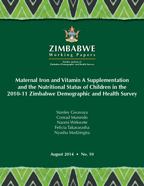
Abstract:
Background: Child stunting is a public health
problem in developing countries. Studies have
shown that maternal nutrition is an important
determinant of fetal and postnatal growth.
However, the diets of women in developing
countries are often deficient in energy,
protein and vital micronutrients. Improving
the health and nutrition of mothers and
mothers-to-be is important in addressing many
underlying causes of child malnutrition.
Hence strategies to improve children’s
nutritional status and growth should include
interventions to improve nutrition of
pregnant and lactating women. The World
Health Organization (WHO) advises that, to
improve children’s growth, pregnant women in
developing countries should take iron
supplements, and lactating mothers should
take Vitamin A supplements. Despite the
implementation of these interventions, there
is little information on how antenatal and
postnatal maternal micronutrient supplements
influence child growth in developing
countries.
Objective: Evaluate the role of maternal
Vitamin A and iron supplements on children’s
nutritional status and growth. We compare the
differences in st
unting between children whose mothers
received one or both of these two
micronutrient supplements during pregnancy
and after delivery and children whose mothers
did not receive either of the micronutrients.
Methods: We use cross-sectional survey data
from the Zimbabwe Demographic and Health
Survey of 2010-11 (ZDHS 2010-11). A
stratified, two-stage cluster design was used
for the survey. For our analysis we use data
from 2,007 children under age 3 whose
anthropometric measurements were recorded
during the survey. Logistic regression
analysis was used to identify determinants of
child nutritional status, defined as height-
for-age (stunting).
Results: Forty percent of the mothers
received postpartum Vitamin A supplements,
while 53% received iron supplements during
pregnancy. Results show that maternal iron
supplements reduced child stunting (aOR =
0.73; 95% CI = (0.58, 0.91); p = 0.006).
However, Vitamin A supplementation did not
have an effect on child stunting (aOR = 1.09;
95% CI = (0.86, 1.37); p = 0 .474).
Conclusion: The results of this study
indicate that maternal iron supplementation
during pregnancy reduces early childhood
malnutrition, especially stunting. Postpartum
Vitamin A supplementation, however, does not
appear to have an effect on the nutritional
status of children. The effects of Vitamin A
supplements on child nutrition may be
indirect, and may not necessarily be on child
growth but rather on other children’s health
and developmental issues.
 Maternal Iron and Vitamin A Supplementation and the Nutritional Status of Children in the 2010-11 Zimbabwe Demographic and Health Survey (PDF, 1865K)
Maternal Iron and Vitamin A Supplementation and the Nutritional Status of Children in the 2010-11 Zimbabwe Demographic and Health Survey (PDF, 1865K)
